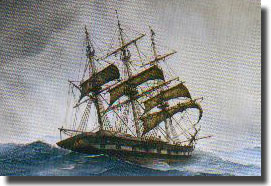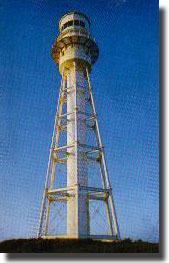|
The emigrant ship, Cataraqui, wrecked on the 4th. of August 1845
 | Denise and I have visited King Island, which stands like a sentinel, almost south of Capte Otway, guarding the western entrance to the notorious stretch of water Bass Strait, I was fascinated by its Maritime History.
It was named after Philip King, the Governor of New South Wales in 1801, and squats astride the "Roaring Forties" directly in the path of the prevailing westerlies that drove the sailing vessels loaded with convicts and emigrants from the Old World to the new South Land.
In the 19th. Century, it had lured ships to a watery grave, just as old fashioned sticky fly paper had entrapped its victims.
Cape Wickham Lighthouse completed in 1861
 | The tallest lighthouse in Austrailia, a 52 metre high light, built from local granite, was not erected on the northern tip of the island at Cape Wickham, until 1861.
In 1835, the barque Neva, with a crew of 27, transporting 159 women and 55 children from Cork in Ireland to Sydney, running before a strong westerly, foundered close to the northern tip of King Island.
The 837 ton ship, quickly broke up into 4 pieces, 22 made it ashore, but of the 241 people on board, but 15 survived.
It was in 1845, that the Cataraqui, out of Liverpool, with 409 on board, was forced by bad weather to rely on dead reckoning, with her Master believing he was just off Cape Otway, when in fact, he was 80 miles further south.
In torrential rain, on the blackest of nights, he sailed this iron bound barque into the rocks only 150 meters from the shore, at what in now called Cataraqui Point, on the south west corner of King Island.
400 died that night, leaving only 9 to survive, a mass grave, only located in 1994, houses 206 bodies, and is today marked with a Memorial Cairn.
The Neherby, in 1866, sailing from London and bound for Brisbane in Queensland, with a crew of 52 carrying 454 passengers, struck a reef near Currie on the island's west coast.
Everyone was ferried safely ashore, and on the 2nd. day at the rough camp that had been set up, a child was born. The tartan rug used to protect this baby may be viewed at the Currie Museum, now housed in the original building used by the Curie Lighthouse keeper as his home.
John Parry, the 2nd. Officer, with 9 passengers from the wreck, walked for 4 days to Cape Wickham, on the northern end of the island.
The borrowed a whaleboat, crossed the Bass Strait, landing near Barwon Heads on the western side of Port Phillip Bay. Parry now borrowed a house, and rode into Geelong, where he telegraphed news of this disaster to Melbourne, arranging for a rescue operation to get under way.
The Maritime disasters continued, in 1871, the Lock Leven and the Ocean Bride both came to grief.
1874 and 1875, found the British Admiral and Blencathra respectively ending their days on the rocks close to Currie.
Although the provision of a lighthouse as Cape Wickham had materially assisted sailors, this light was sometimes mistaken for the Cape Otway light, and ships thus sailed south and east thinking they were safe, only to run onto the rocks or reefs off the dangerous west coast of King Island.
If we go back to 1852, the City of Melbourne, of 139 tons, built only the year before as the first propeller driven steamer in Australia, struck a rock with one propeller and had to be beached, she was however salvaged, and lived to sail again.
Currie steel lighthouse assembled in 1879
 | In 1879, another lighthouse was erected at Currie, it had been prefabricated in the England, and transported out in 417 pieces, to be reassembled on site and,, to reach the lamp room necessitated climbing 90 spiral steps.
In the 20th century, shops continued to be wrecked on King Island's shores.
The Carnarvon Bay in 1910, the Bronze Wing in 1914, a ketch of only 78 tons whilst assisting in the building of a jetty at Narcoopa on the east coast, dragged her anchors during a fierce gale, and was subsequently wrecked.
In 1920, the Southern Cross, a 257 ton barquentine, sailed for Hobart from Williamstown in Victoria, par of her cargo was 8,000 gallons of benzene, packaged in 4 gallon drums, two at a time, each pair in their own wooden case. She did not arrive, and eventually, a charred wreckage was washed up off Reid Rocks, and no further trace of this vessel, or any of her crew were ever found.
A third major lighthouse, a 10 metre concrete tower, at Stokes Point, on the Island's Southern tip, completed the aids to navigation in this graveyard of both sailing and steam driven ships.
Today King Island, but 45 minutes by air from Melbourne, or 30 minutes from Wynyard in Tasmania, has a population of some 2,000, there is virtually no unemployment on this friendly island about 64 kilometers long by 27 kilometers wide.
The small island is renowned for its find beef, succulent crayfish, and dairy products, all air freighted to the Australian mainland.
It is a supplier of Bull Kelp, processed as alginates, and finding a 1,000 used as gelling agents, and stabilizers across the world.
A visit to this quite unusual tourist attraction is recommended, fly over, hire a car , and drive over the roads of this lush green island, and don't miss a visit to the King Island Cheese Factory, their products are mouth watering.
|